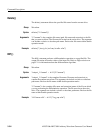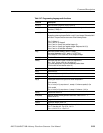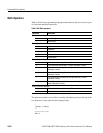
Command Descriptions
AWG710&AWG710B Arbitrary Waveform Generator User Manual 3-199
Arguments
"output_filename" is the complete file name (file name and extension) to
contain the resultant waveform. The argument can include a relative or absolute
path name. Enclose the file name within double quotation marks.
"filename" is the complete name (path, file name and extension) of the source file
for the integration operation. The file must be on the active drive. The argument
can include a relative or absolute path name. Enclose the file name within double
quotation marks.
Example
"intwave.wfm" = integ("sineswp.wfm")
Join( )
The join() statement joins (concatenates) two waveform files (waveform and
marker data) into a single file. The clock sample rate in first file sets the clock
sample rate for the output file waveform. You can only concatenate waveform
(.wfm) files.
Group
Waveform
Syntax
"output_filename" = join("filename1", "filename2")
Arguments
"output_filename" is the complete file name (file name and extension) to
contain the concatenated files. The argument can include a relative or absolute path
name. Enclose the file name within double quotation marks.
"filename1" and "filename2" are the complete names (path, file name, and
extension) of the files you are concatenating. Both files must be on the active drive.
The argument can include a relative or absolute path name. Enclose each file name
within double quotation marks.
Example
"newsine.wfm" = join("sine.wfm", sine2.wfm")
Lpf( )
The lpf() statement creates a new file by passing the specified waveform file
through a low pass filter.
Group
Waveform
Syntax
"output_filename" = lpf("filename1", cutoff_freq, taps, atten)


















